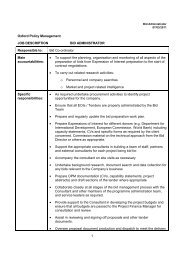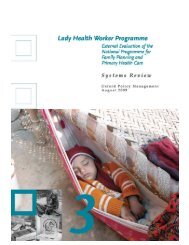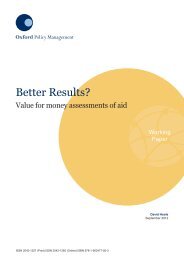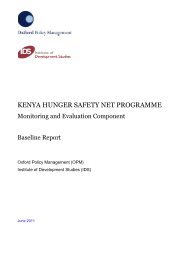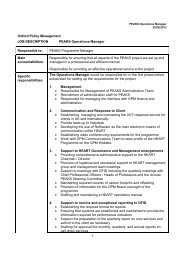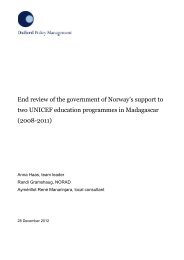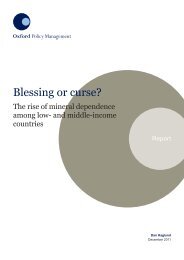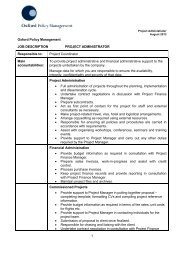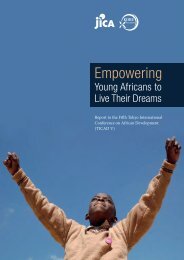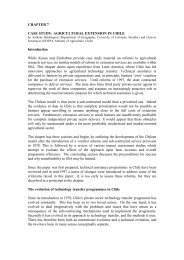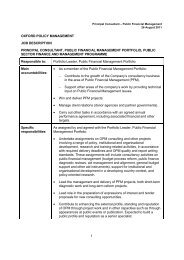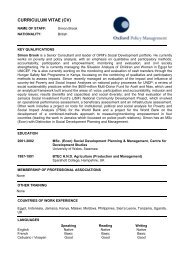LHW Punjab and ICT Report - Oxford Policy Management
LHW Punjab and ICT Report - Oxford Policy Management
LHW Punjab and ICT Report - Oxford Policy Management
Create successful ePaper yourself
Turn your PDF publications into a flip-book with our unique Google optimized e-Paper software.
EVALUATING THE LADY HEALTH WORKER PROGRAMMECHARACTERISTICS OF THE LADY HEALTH WORKER AND HERSUPERVISORThe Programme has specific recruitment criteria for Lady Health Workers <strong>and</strong> theirSupervisors. It is important for Programme credibility <strong>and</strong> reputation as a professional servicethat these criteria, once determined, are adhered to. 4Age <strong>and</strong> Marital Status: <strong>LHW</strong>s should be between twenty <strong>and</strong> fifty years old,though if married eighteen <strong>and</strong> nineteen-year-olds are acceptable. <strong>Punjab</strong>i <strong>and</strong> <strong>ICT</strong> <strong>LHW</strong>smet these criteria. The majority of <strong>Punjab</strong>i <strong>and</strong> <strong>ICT</strong> Lady Health Workers, sixty-threepercent, are currently married as preferred by the programme. The Supervisors, bothnationally <strong>and</strong> in <strong>Punjab</strong> <strong>and</strong> <strong>ICT</strong>, are also typically in their late twenties <strong>and</strong> just over half ofthem are married.Education: <strong>LHW</strong>s should be educated to at least the eighth class, though it ispreferable for them to be matriculated. Based on <strong>LHW</strong>s own reports, <strong>Punjab</strong>i <strong>and</strong> <strong>ICT</strong> LadyHealth Workers have an education of at least an 8 th class pass <strong>and</strong> fifty-five percent haveclass ten or above. Over eighty percent of <strong>LHW</strong>s in <strong>Punjab</strong> <strong>and</strong> <strong>ICT</strong> could confirm classachievement through showing their school certificate. While the selection criteria forsupervisors requires at least a class 10 pass, in practice most supervisors are considerablybetter qualified. In <strong>Punjab</strong> <strong>and</strong> <strong>ICT</strong> over half of the supervisors have at least graduateeducation.<strong>LHW</strong> Residence: The vast majority of <strong>LHW</strong>s live in the village/ mohalla in whichthey work, as required by Programme st<strong>and</strong>ards. Nationally four percent are non-residents. In<strong>Punjab</strong> <strong>and</strong> <strong>ICT</strong> it is just over three percent. <strong>LHW</strong>s are very much part of the community theywork in. In <strong>Punjab</strong> <strong>and</strong> <strong>ICT</strong> forty-seven percent of the <strong>LHW</strong>s were born within thecommunity <strong>and</strong> a further forty-six percent have been resident for more than five years.The Programme in <strong>Punjab</strong> <strong>and</strong> <strong>ICT</strong> has been successful in ensuring that the vastmajority of <strong>LHW</strong>s <strong>and</strong> their Supervisors meet the educational, age <strong>and</strong> residency criteria.KEY POINTS• The Lady Health Worker Programme (<strong>LHW</strong>P) has become an important element in theGovernment of Pakistan’s plan to raise the health status of women <strong>and</strong> children invillages <strong>and</strong> poor urban areas.• This report presents information, collected mainly through quantitative surveys on theperformance of the <strong>LHW</strong>P in <strong>Punjab</strong> <strong>and</strong> <strong>ICT</strong>.• The Programme has been successful in ensuring the vast majority of <strong>LHW</strong>s <strong>and</strong> theirSupervisors meet the educational, age <strong>and</strong> residency criteria.4 See Appendix 2 <strong>and</strong> the Quantitative Survey <strong>Report</strong> for more information.3



